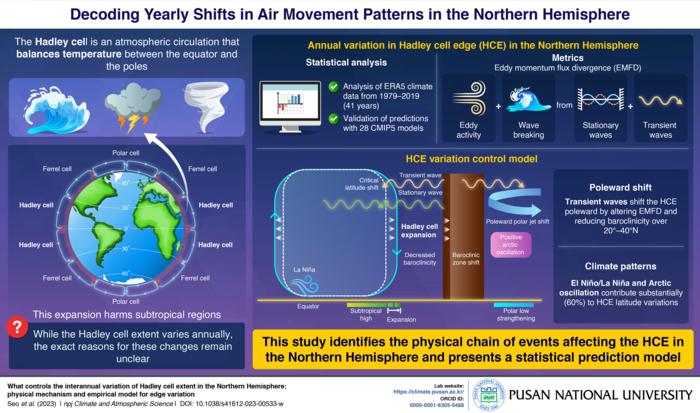The Hadley circulation is a key atmospheric circulation pattern in the tropics. It helps even out the temperature between the equator and the poles by moving energy and momentum toward higher latitudes. However, recent studies indicate that the Hadley circulation cells have expanded toward the poles in the 21st century, increasing by several degrees each year. This expansion can have a substantial impact on the global weather and climate, resulting in adverse events like heatwaves, droughts, and tropical cyclones. Although some studies have investigated the factors affecting the north-south variations of the Hadley cell, there is a lack of understanding about the dynamic mechanisms responsible for the year-to-year shifts.

Credit: Kyong-Hwan Seo from Pusan National University
The Hadley circulation is a key atmospheric circulation pattern in the tropics. It helps even out the temperature between the equator and the poles by moving energy and momentum toward higher latitudes. However, recent studies indicate that the Hadley circulation cells have expanded toward the poles in the 21st century, increasing by several degrees each year. This expansion can have a substantial impact on the global weather and climate, resulting in adverse events like heatwaves, droughts, and tropical cyclones. Although some studies have investigated the factors affecting the north-south variations of the Hadley cell, there is a lack of understanding about the dynamic mechanisms responsible for the year-to-year shifts.
Now, in a recent study published in the journal npj Climate and Atmospheric Science on 7 December 2023, led by Professor Kyong-Hwan Seo from Pusan National University, researchers have proposed a physical model that explains the shifts in the Northern Hemisphere Hadley cell edge latitude. According to Prof. Seo, “During the expanded phase of the Hadley cell, many regions on the periphery of the subtropics experience unfavorable climatic conditions, such as prolonged drought spells and the more frequent occurrence of heat waves. In our study, the physical processes behind the interannual variation of the Hadley cell edge (HCE) latitude have been elucidated for the first time. Changes in subtropical and midlatitude eddy activity, not the change in jet location, control the HCE variation.”
In this study, a total of 41 years of ERA5 climate reanalysis data (compiled by the European Centre for Medium-Range Weather Forecast) and sea surface temperature data were analyzed. The researchers discovered that the changes in the latitude of the Hadley cell were mainly caused by shifts in wind eddy activity and wave breaking from both “stationary” and “transient” waves. Furthermore, a substantial portion of the year-to-year variations was associated with El Niño, La Niña, and the Arctic oscillation. These phenomena contribute to a poleward shift in the Hadley cell edge by inducing poleward movement of eddy activity. Moreover, the outcomes from 28 CMIP5 (Coupled Model Intercomparison Project Phase 5) simulation models were observed to match the observed variations in the Hadley cell, confirming the validity of the proposed mechanism.
The findings from this study are anticipated to be vital in addressing the significant impacts on the regional weather and climate worldwide resulting from the poleward expansion of the Hadley cell. This involves effects such as worsening aridity in the American Southwest, Mediterranean Europe, and southern China in the Northern Hemisphere, as well as reduced precipitation in southern Australia and southern Amazonia in the Southern Hemisphere.
“The rise in heatwaves in central and western Europe could be linked to the Hadley cell’s expansion during boreal summer. This expansion also shifts tropical cyclone tracks poleward, due to the poleward bulge of the subtropical high-pressure zone. Our study offers crucial insights into the physical events driving this expansion,” points out Prof. Seo.
Overall, this research is expected to have significant implications on our understanding of regional as well as global weather patterns!
***
Reference
Title of original paper: What controls the interannual variation of Hadley cell extent in the Northern Hemisphere: physical mechanism and empirical model for edge variation
Journal: npj Climate and Atmospheric Science
DOI: https://doi.org/10.1038/s41612-023-00533-w
About the institute
Pusan National University (PNU), also known as Busan National University, stands as one of the ten flagship Korean National Universities in South Korea. Widely recognized as the second-ranking public university, following Seoul National University, among the flagship institutions, PNU holds historical significance as the first national university established after the National Liberation Day of Korea. The university comprises four campuses: Busan Campus, Ami Campus, Miryang Campus, and Yangsan Campus, situated in Busan and South Gyeongsang Province. The university now consists of fifteen colleges, one independent division, one general graduate school, four professional graduate schools, and five special graduate schools. PNU actively contributes to the nation’s development by nurturing prominent experts and cultivating talented leaders.
Website: https://www.pusan.ac.kr/eng/CMS/Contents/Contents.do?mCode=MN073
About the author
Kyong-Hwan Seo is a Professor of Atmospheric Sciences and Director of Institute for Future Earth at Pusan National University. His interests encompass a wide range of areas including climate and atmospheric dynamics, tropical meteorology, climate change and modeling, and Arctic/Antarctic processes and modeling. The specific major topics are the Hadley circulation, Madden-Julian oscillation, wave dynamics, teleconnection, monsoon dynamics, extreme weather, and climate processes, etc. Before coming to Pusan National University, he worked as a Climate Scientist at Climate Prediction Center/NCEP/NOAA in USA. Kyong-Hwan Seo received a PhD in Atmospheric Sciences from Texas A&M University in 2001 and he was awarded a Presidential Commendation in 2023 in recognition of contributions to monsoon dynamics.
Website: https://climate.pusan.ac.kr
ORCIE id : 0000-0001-6305-5488
Journal
npj Climate and Atmospheric Science
DOI
10.1038/s41612-023-00533-w
Method of Research
Computational simulation/modeling
Subject of Research
Not applicable
Article Title
What controls the interannual variation of Hadley cell extent in the Northern Hemisphere: physical mechanism and empirical model for edge variation
Article Publication Date
7-Dec-2023
COI Statement
The authors declare no competing interests.




